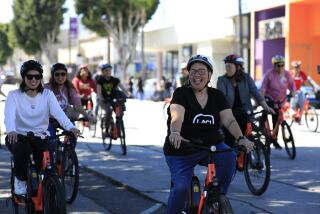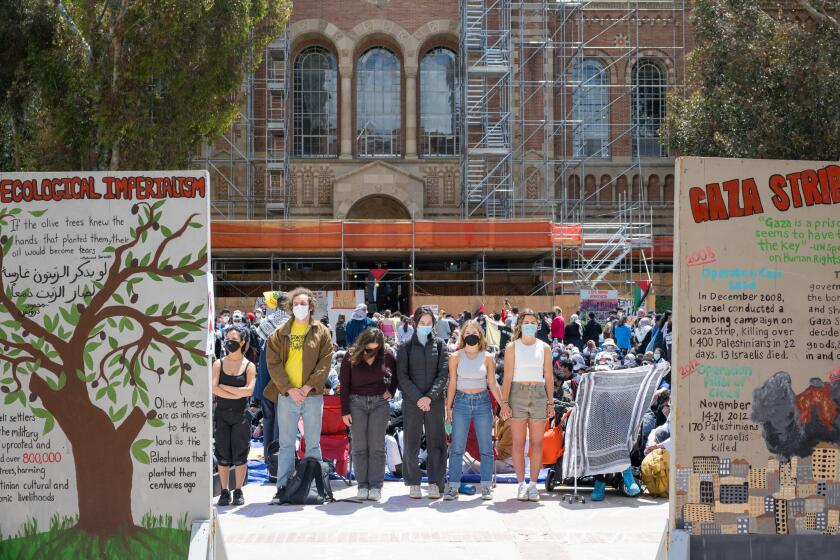Hitting CicLAvia on a pedicycle
At CicLAvia on Sunday, when the city of Los Angeles closed 7.5 miles of streets to cars and turned the roads into a bike festival, all manner of foot-powered transport was on parade. There were racing bikes and practical bikes, tandem bicycles and parents carting toddlers, and bikes with baskets, racks and trailers.
And then there were my wheels. As I sat on the steps of the entrance to the Los Angeles Times, watching cyclists whiz by, Colin Bogart sauntered up in a custom-made pedicycle -- really a gigantic tricycle equipped with a leather passenger side seat next to his. Tricked out with a purple cloth canopy and festooned with fall foliage and Halloween decorations, it had a kind of surrey-with-the-fringe-on-top vibe.
“Your ride is here,” he said with a grin. I climbed on and we were off down Spring Street with two cyclist pals behind us.
FULL COVERAGE: Sharing the road in L.A.
I got my last bike when I was 11. (A very long time ago.) And I haven’t really wanted another one since. The only vehicles I care about have a lot of horsepower and good sound systems. I wouldn’t have even been riding in CicLAvia if it weren’t for the fact that I broke my foot and Michelle Mowery, the senior bicycle coordinator for the Los Angeles Department of Transportation -- whom I’ll be blogging about later in the week -- offered to put the word out about getting me a ride on a pedicycle or similar bike. Within half an hour, the bike community had come through.
“I’ve got to remember to stop this thing with the pedals in the right position,” Bogart said with a delighted laugh. He’s the education director of the L.A. County Bicycle Coalition. No one knows more about bike safety than Bogart, but this hand-built bike was graciously loaned to us, so he was adjusting to it as well.
The speed was leisurely -- with occasional jolts from bumpy roads -- and the experience as intoxicating as all the cyclists I know had promised. On a bike -- with no cars to worry about -- downtown is a vivid panorama of old building facades, new restaurants, pop-up stores (the Kitty Bungalow -- “Charm School for Wayward Cats.”) Everything is up close and unfiltered by a car window -- the hipster on his balcony loft talking on the phone, a gaggle of men sitting outside on a curb. We wandered off the closed course to stop and eat ice cream at Peddler’s Creamery, where bicycles are rigged up to power an ice cream churn. (Who knew?)
By the time Bogart deposited me back at the front of The Times, I was enchanted with downtown and the philosophy of “calming” traffic -- slowing it down -- in various neighborhoods to allow bicyclists and pedestrian to ride and walk more safely. After all, I felt so calm. Maybe this really works.
“Next CicLAvia, your foot will be healed and you can ride a bike,” said Jen Klausner, executive director of the L.A. County Bicycle Coalition, who had been riding with us.
Sure. (Maybe.) I nodded.
Then I hobbled back to my car and drove home to the Westside. Within half an hour, I was weaving my way through Sunday afternoon traffic on Santa Monica Boulevard, gunning my car around slow drivers and shooting up Centinela looking for a faster way home, fuming at ill-timed traffic lights that seemed determined to make me trudge all the way.
What happened to my CicLAvia mellow? I thought back on all the slow-traffic-is-better talk I had heard and realized: I want to go as fast as I can in my car. Period.
OK, so I’m still struggling with the idea of Los Angeles melding cars and bikes. But I’m not alone, and the important thing is for us all to have this conversation about bikes and cars and sharing the road. Because we’re all here to stay.
However, I am convinced of this: There’s no better way to travel Spring Street than on a pedicycle.
ALSO:
Yosemite’s burned areas are alive
This post is part of an ongoing conversation to explore how the city’s cyclists, drivers and pedestrians share and compete for road space, and to consider policy choices that keep people safe and traffic flowing. For more: latimes.com/roadshare and #roadshareLA.
More to Read
A cure for the common opinion
Get thought-provoking perspectives with our weekly newsletter.
You may occasionally receive promotional content from the Los Angeles Times.







